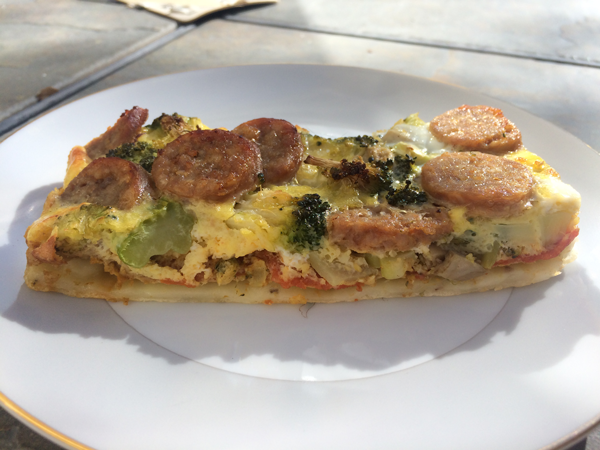I recently received the following question about dairy and pizza…
I was wondering what your thoughts are on occasional grass fed dairy (even raw) and a Paleo Pizza?
I have been gluten free for over a year ( I was really sick, so it made a huge difference) and I have recently discovered for sure that corn it a problem for me too.
I don’t drink caffeine and I’m not a sugar person, so the 30 day jump start is not a big problem for me ( I like to cook and I have already enjoyed cooking new things – butternut squash “hummus” yesterday!) But I am already dreaming about pizza ): I am excited to try a cauliflower crust ( and since I don’t eat gluten haven’t had real crust in a while anyway) – but I cannot figure out how to replace the cheese and get that melty deliciousness – so I’m wondering if you have any pizza suggestions?
(I may end up trying grass fed and raw mozzarella or goat cheese AFTER the thirty days if I can’t come up with an alternative)
Thanks for your time!
I figured this nice woman was not the only person dreaming of pizza. I do it all the time, so here is my answer for ya!
I eat “pizza” all the time, but it doesn’t involve dairy or grains. There are a couple ways you can go about it, but first let me give you an answer on the dairy question.
Is Dairy for You?
Most people who have a serious sensitivity to gluten (which it sounds like you do) also have issues with dairy, unfortunately. Even raw dairy. However, some people can deal with it, so if you really really want to, give it a try and see how your body responds. Like you said, I’d suggest eating raw, full fat dairy, or at least raw. You can get cheeses from Whole Foods that are raw. So try it out, but really watch your body’s response to it over the next few days. Do a full body scan a few times a day, asking in particular these questions:
- Am I more phlegmy than usual?
- Do I have a yeast infection?
- Is my skin breaking out in acne or a rash?
- Am I itchy anywhere?
- How’s my digestion – am I bloated, do I have diarrhea, am I constipated?
- How am I mentally – foggy, tired, etc?
Dairy is a powerful thing, and a sensitivity to it doesn’t always manifest itself in the usual gassy/bloating ways. If you find that you get symptoms from it, take those seriously and stop eating it, except on rare occasions (or never if you’re like me).
How To Make Paleo Pizza
Ok, as for the pizza thing, if you want to try out the pizza with raw dairy at some point, go for it. But a more Paleo substitute for cheese is called Daiya, which you can get at almost any natural food store or on Amazon. It’s mostly made of tapioca and seasonings, but there is a little bit of some sort of legume flour in it, too, so the choice to eat it is all yours, of course.
The crust. This is the amazing part. My husband and I make pizzas all the time using Chebe pizza crusts, which are cheap and on Amazon, and made out of tapioca flour, which is a root and not a grain, and totally Paleo. It’s high in carbs, but you can make the crust very thin so that you’re not overdoing it. Then we use dijon mustard as the “sauce”, which doubles as the cheese, actually. I know it sounds weird, but my mother – the most non-Paleo person in the world – LOVES it.
We don’t eat tomatoes (they bother my husband and I don’t really care about them), so this is perfect for someone on the autoimmune protocol. In any case, the mustard really does give it a nice flavor and saltiness that the cheese usually provides.
The other thing we do that makes it have more of the consistency of cheese is to add eggs. I know – all of this sounds so weird! But we use a higher lipped pan, spread out the Chebe dough (which takes about 2 minutes to make), add lots of mustard, then pepperoni, then veggies (broccoli, mushrooms, zucchini, artichoke hearts, etc.). Then some sort of ground meat (turkey with lots of seasoning on it, or Italian pork sausage). Then we add about 7 beaten eggs over the whole thing, put it in the oven for about 25 minutes until the eggs are cooked, and enjoy.
I hope that helps! Please let me know if you do this and how it turns out for you. I’d love suggestions on how to make it even better. Or let us know in the comments how YOU make pizza.













Hi, Neely – I just got the Chebe pizza crust mix. It says for best results to mix in 1 cup of shredded cheese. You didn’t mention making any substitutions, so I assume you just skip that ingredient? Have you ever substituted anything in the crust for that cheese? Thanks! (Your pizza looks delicious, BTW.)
Neely, I’m wondering if you know if your dairy issues are from the lactose or the proteins or from what the cows were fed whose milk you were drinking? Are you sensitive to cultured goat milk if the goats are 100% grain free? I’m going dairy free for 2 weeks to test how I feel. We are getting ready to test our cows to see which are A2A2 beta-casein (the same protein in goat milk versus the common A1 protein in most commercial Holsteins.) My theory is that some people are reacting to the grain fed to the cows, so when I add back in milk I will ensure it is 100% grass-fed raw milk from A2 cows as a starting point. But I will likely culture it to minimize the complex carb load and potential lactose intolerance issue.
I’m going dairy free for 2 weeks to test how I feel. We are getting ready to test our cows to see which are A2A2 beta-casein (the same protein in goat milk versus the common A1 protein in most commercial Holsteins.) My theory is that some people are reacting to the grain fed to the cows, so when I add back in milk I will ensure it is 100% grass-fed raw milk from A2 cows as a starting point. But I will likely culture it to minimize the complex carb load and potential lactose intolerance issue.
I’m moving more and more toward a Paleo lifestyle, but we run an integrated sustainable farm which includes dual purpose milk/meat 100% grass-fed Jersey cows. The fact that I milk cows every day, I’m struggling with the whole dairy-free thing
I’m just wondering if you ever personally tried that “test” to see if the feed of the animals or their A2 status made a difference in how you tolerated it. (There are not a lot of 100% grass-fed dairies out there.)
From a sustainable farming perspective, I feel like dairy cows play a vital role in the symbiotic system from both a financial and fertility angle. The excess milk is great for pastured hens and pigs to round out their amino acid profiles without having to supplement them with a bunch of grain. We started our farm 4 years ago with the intent of having it be a healing retreat. As a farmer trying to produce the healthiest food possible, I believe the production model can make a huge difference in the quality and healthiness of the food. I know your whole angle is to personalize the person’s diet based on what they can tolerate, so I’m just wondering if you’ve ever drilled down that far with a person’s dairy sensitivity.
Hi Rachel – Thanks for this great question! Yes, I’ve absolutely gone down this rabbit hole with dairy for myself and clients. I’ve tried eating local raw dairy, local raw fermented dairy, and raw cheese and always have the same problems. I think mine is a sensitivity to casein or some other protein in the dairy as well as lactose intolerance. However, what I’ve found interesting is that when I was in Europe I could eat their dairy there with no problems (besides gaining 7 pounds in a month due to overconsumption of gelato ;). There’s a genetic difference between our dairy and their dairy cattle that I’d love to explore more, but just haven’t had the time for it. I appreciate what you do, and I think if people don’t have problems with dairy, they should for sure opt for milk like yours. I completely agree that everyone should eat what they personally tolerate, and for some people that means dairy. I always advocate finding out for sure what your body can tolerate, though, which means taking that food out for a month or so.
Sounds delicious! What type mustard works best? Yellow? Dijon? Is there a brand you prefer for this pizza?
Michelle – Any dijon mustard works well for us, but I suppose any mustard would be good.
Ok, I’m very curious. Could you post a photo if this finished dish?
Gary – I just posted a photo of some pizza we had in the fridge that I reheated – hope that helps!
Neely I am so excited by your response because it confirms my hypothesis. The fact that you could consume dairy in Europe could have been for 1 of 2 reasons:
1. You are intolerant to the A1 beta-casein but NOT the A2 beta-casein.
You are exactly correct that there is a genetic difference between cows in Europe and the cows in the US. It is called the A2 gene to produce milk with the A2 Beta-casein protein vs the A1 beta-casein protein.
Each cow carries two copies of the gene which determines their beta-casein. So a cow can have one of these 3 genotypes: A1/A1, A1/A2, or A2/A2. An A1/A2 cow will produce 50% of each protein. An A2/A2 cow would only produce the A2 protein, and an A1/A1 cows would produce only the A1 protein.
American herds are dominated by Holstein cows, which tend to be A1/A1 or A1/A2 Jersey cows and other Southern European breeds have a 50-70% chance of producing milk with only the A2 proteins. Guernsey cows generally have a 70-90% chance of being A2/A2.
The issue with milk containing A1 beta-casein is that the 67th amino acid is a histidine, rather than a proline (found in the A2 protein.) The histidine amino acid at this location readily allows a digestive enzyme to cut off a 7 amino acid segment (this does not occur when a proline amino acid is in that spot with the A2 protein). The 7 amino acid segment that is separated from A1 beta casein is known as beta-casomorphin-7, often abbreviated as BCM-7.
BCM-7 is is an exogenous (doesn’t naturally occur within the human body) opioid that interacts with the human digestive system, internal organs, and brain. (It often fills the SAME opiate receptors as the exogeneous opioids found in modern wheat, which is why people with wheat intolerances often have intolerances to A1 dairy. BCM-7 has been linked to type 1 diabetes, heart disease, autism, and other diseases as well.
The only way for a local farmer to know the genotype of his cows is to have them genetically tested. The price of the test has come down to $25 in recent years. We will be getting our herd tested this month. But just buying milk from local Jersey cows doesn’t guarantee the milk is A2 milk. My guess is that if you got milk from a local farmer who’d had his cows tested as A2/A2, you might not react.
2. The other possible reason that European dairy doesn’t cause you issues is that feeding GMO grains to cows is much less likely in Europe, and many more of the dairies there are grass-fed.
Before I moved to our farm in April 2011, I was doing nutrition testing with a “bio-feedback machine” also called electro-dermal testing using an Interogatory Query System. I was consistently finding that most people’s illnesses were directly connected to what they were eating, but I felt like there was something missing from the picture. I started to feel like the production model for the food made a much bigger impact on the food quality and potential for sensitivity than we imagined. I felt like I was getting mixed readings on some people, like we were asking the wrong questions–that it was too broad to ask, “What is the value/stress of eating dairy for this person?” That the way the dairy was produced was the bigger question.
It wasn’t until I started milking cows that I was even introduced to the concept of A2 milk. And it took me 3 1/2 years of research to really decide I needed to convert my herd to A2 genetics. Becoming a producer was also the only way I got a clear picture of the challenges facing farmers regarding how to feed dairy cows.
Even most small local farmers still supplement their cows with GMO corn and soy. Feeding no GMO’s and even better–no grain–took significant effort and cost that I wasn’t even aware of before I got my shoes covered in manure
The challenge is that there is a disconnect too often between the nutrition community and the producers. Hopefully we can begin to bridge that gap more and more so the food being produced will actually be able to be eaten by people without making them sick–food that truly nourishes.
P.S. I’m really interested in referring my mailing list to your Women’s Weight Loss Workshop the next time you open registration–I don’t know that I could get the word out in time before tomorrow’s class starts. It looks like a really comprehensive program! You definitely know your stuff!
This sounds like an excellent alternative to making the paleo dough from scratch myself.
I’ve never heard of the chebe pizza crusts so this will be a fun experiment for us! Oh and paleo pesto is to die for on pizza.
Neely would you happen to have a picture of the final product? I’d like to see what the cooked eggs look like on top of this concoction that has me salivating through the screen…must be lunch time or something.
Well, I am skeptical, but I’ll give it a try. After all, you never know unless you actually test it!
Whoa! It’s like you wrote this article for me – I’ve been dreaming of pizza, too. I am also trying 30 days of dairy-freeness after 2 years of living gluten free and Paleo-inspired (but not dairy-free). I miss my lattes and pizza sooooo much. But it’s only Day 7. Thanks for the tips and advice!
Sounds very interesting! What kind of mustard do you use?
Christine – I use any dijon mustard, but any mustard would probably work well.
I make a pizza with Carmelized onions, capers, and lots of olive oil- I don’t miss the cheese at all!
Try using a paleo pesto in lieu of sauce?